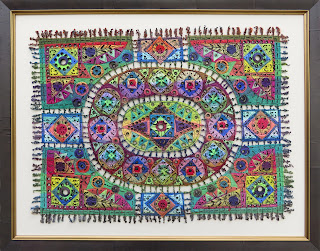Sometimes I just can't help myself when attending Bill Mishoe's auction. I will leave a six-dollar/minimum "mercy bid" for items I don't need and for which I have no use and no brilliant ideas. Such was the situation with a very large, extremely heavy, well worn blue-and-white needlepoint rug.
Some one stitched it ... BEAUTIFULLY. I don't know who. I don't know why the family consigned it to the auction house. It was as if this rug came from
Rudolf the Red-Nosed Reindeer's Island of Misfit Toys ... neglected,
unloved, cast away, holding stories of an anonymous family and a once
perfect living room, almost begging for "someone" to take it home and
give it a "second life". How could I help myself? Of course I left a six-dollar bid. The rug was then mine.
Even Ernie the Cat seemed to know that the rug was in a "better place" ... though he had no helpful ideas for how I might incorporate it into my studio practice. The rug sat around for more than two months before I finally cut it into the twelve, nearly square sections that made up its design. I took the twelve pieces to my two-week art residency at the Rensing Center where I used an entire gallon of GAC 400 Fabric Stiffener on the twelve pieces. Sure ... I was mentally chastising myself for the expenditure. I'd just poured over $80 of an acrylic medium over a six-dollar mercy bid and still had no idea how I was going to use any of it. I had to trust my "bleeding heart". Something would come along to make sense out of all this!
Well ... something did happen! When it did, I knew in an instant exactly what to do and how to do it! My friend Dolly Patton, the new executive director of the Arts Center of Kershaw County, contacted me for a solo show! It seems that the visual arts exhibition space needed a show to coordinate with the annual and upcoming Carolina Downhome Blues Festival in Camden, South Carolina. Dolly asked if I would bring one of my first installations, Blues Chapel, to the Arts Center. Of course I would!
(Above: Two steps in the Photoshop manipulation of the image.)There was a caveat: The show needed to pay homage to one of the festival's most important, previous performers ... Beverly "Guitar" Watkins. Thankfully, Dolly had already secured permission and a high resolution image from photographer Bill Blizard. I went to work immediately ... eliminating the background ... sizing the image for the needlepoint rug, applying the "cutout" filter, and flipping the result so that it would appear correctly when transferred to the needlepoint surface.
(Above: The black-and-white photocopy lathered with matte medium and positioned onto the needlepoint rug ... which was also coated with additional matte medium.)Even though the Photoshop work took less than an hour, the preparation of the rug took a week. Every day, I brushed on a new layer of acrylic medium. Some days, I managed two coats. In all, at least nine layers of matte medium went onto the stiffened section of rug. The layers of matte medium built up the surface into a nice, flat, evenly spread plane ... perfect for an acrylic-to-acrylic photocopy transfer. Both the over-sized print and the rug were finally covered with matte medium and pressed together. When totally dry, I also flattened it in my dry mount press. This made sure that there were no bubbles between the layers. The ink was fused into the acrylic.
(Above: Starting to rub off the excess paper.)Then the fun began! All the excess paper was rubbed off. While this might sound ideal, the results rarely are perfect. Some of the ink does come away with the paper. Some of the gray tones didn't show up well against the needlepoint. Yet, it was enough of a transfer to allow me to over-paint the entire figure in black and shades of gray. Then, I added the gold metallic halo. This halo was also part of the Arts Center's request because all twenty-four of my Blues singers in Blues Chapel do have gold halos. To me, the halo is a symbol for the disadvantages faced by female blues singers: racism, sexism, and a once disreputable music industry. Yet ... they kept singing and sharing and making a better future for the next generation.
(Above: Beverly "Guitar" Watkins, in progress.)After applying the halo, I beaded the rim and added accents, black beer caps on which I placed silver star sequins and another bead. Finally, the piece was ready for its unique presentation. I painted a wide stretcher bar black and filled it with acid-free foam-centered board. The artwork was glued in place ...
... and literally tacked to the wooden stretcher bar.
I am very, very pleased about this piece. It fulfilled the unknown reason for buying the needlepoint rug in the first place. It is honoring a Blues icon. It will be in a show this coming October! I still have no idea what will become of the other eleven pieces of the rug. Perhaps nothing ... but at least "second life" did happen in a beautiful Bluesy way!

































